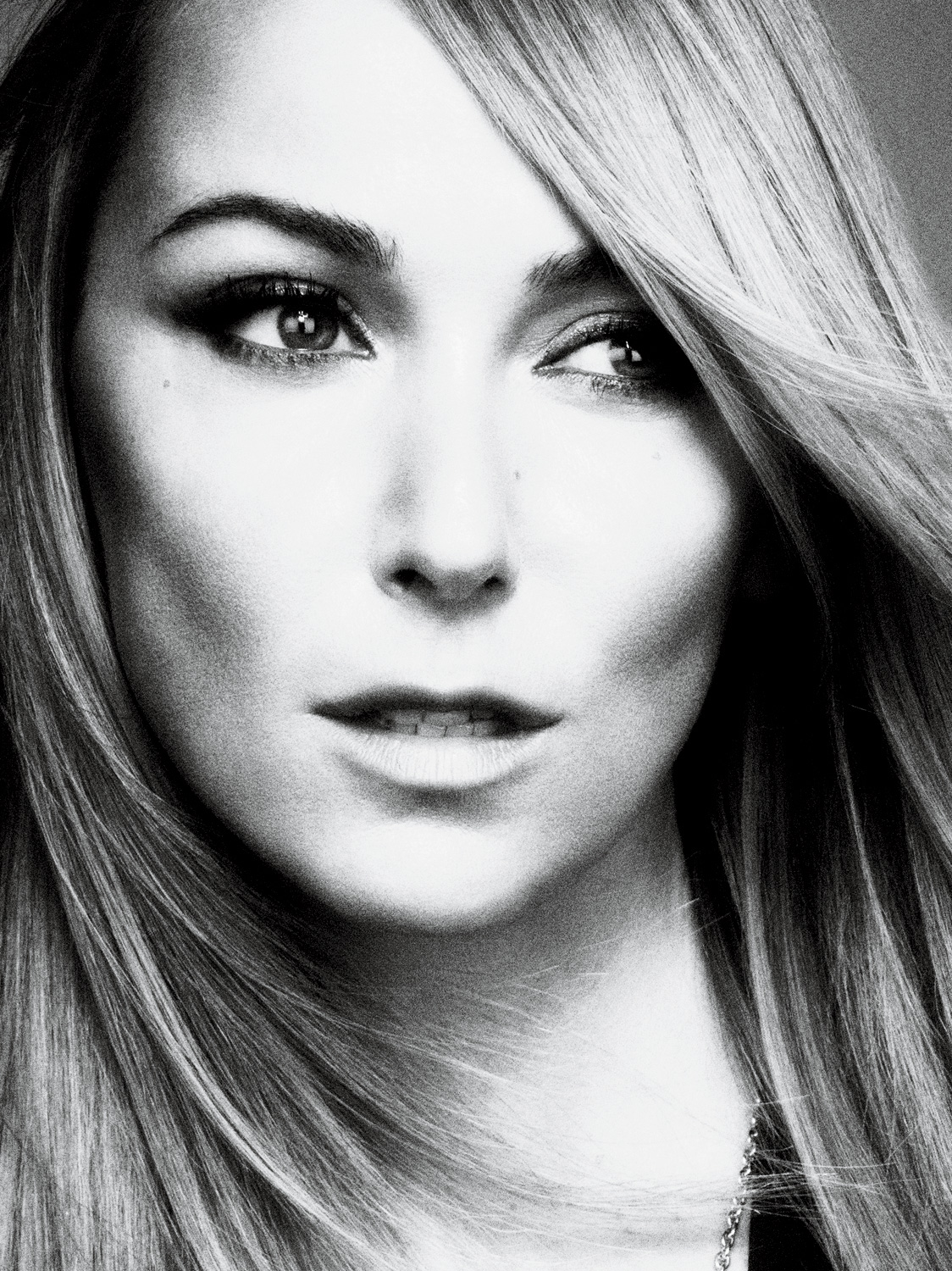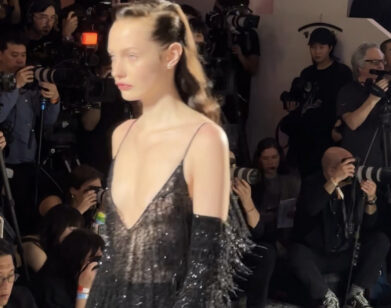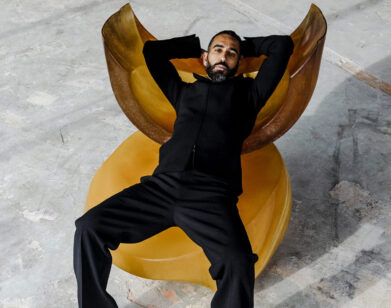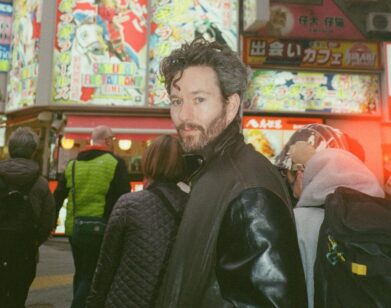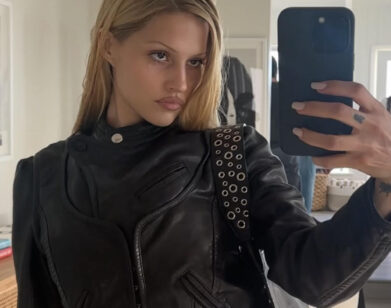Frida Giannini
In addition to fashion, which she creates for a living, and music, which she listens to constantly and collects voraciously in styl- ishly antiquated vinyl form, Frida Giannini is a bit of a gearhead. In fact, she claims to have come up with some of her best ideas in cars. So it’s appropriate that as Giannini attempts to make good use of what’s left of the summer by shuttling between her office in Rome and her beach house in the town of Sabaudia (on the Italian coast) behind the wheel of her Audi Q7 SUV, the Gucci designer would take the opportunity to contemplate the Italian house’s yearlong celebration of its 90th anniversary. That mile marker is punctuated by the recent launch of the 1921 Collection—a line of ready-to-wear clothes and accessories inspired by some of the more iconic materials and moments in Gucci’s history—and a blowout event set to take place next month at the new Gucci museum in the company’s original hometown of Florence, where many items from the run of the house’s vast archives will be made available for public viewing for the first time.

For most of Giannini’s tenure at Gucci—serving as a designer for the last nine years and the house’s creative director for the last five—outrunning the past has been a complicated endeavor, both in terms of the near-mythic aura that surrounds founder Guccio Gucci’s beginnings as a purveyor of leather goods and luggage, whose earnest admiration for luxe handiwork beget an interna- tional empire, and in terms of the more palpable aura that still surrounds the label’s previous creative director, Tom Ford. But Giannini has acquitted herself ably on all fronts, crafting a new chapter in the Gucci story by embracing her own ultra-feminine take on fashion, one that doesn’t so much wrestle with what was, or the iconographic power of those interlocking Gs, as display an unbridled enthusiasm for what is and what might be if we could only find a way to chill out and live in the now.
Depeche Mode front man Dave Gahan recently connected with the 38-year-old Giannini, who was in Florence for work, to discuss Gucci’s big nine-oh and why it’s important to at least peek in the rearview before racing off into the future.
DAVE GAHAN: Congratulations on the anniversary.
FRIDA GIANNINI: Thank you very much.
GAHAN: I’m sure it’s an amazing thing to be part of something that’s lasted so long. I sort of know how that feels, having been in a band that’s been around . . . not quite as long as Gucci, but, you know, we’ve been together for 31 years now, and when you look back on that, it’s quite an achievement. There’s a lot of his- tory. Your more recent collections reference the history of Gucci maybe a bit more than your collections did when you first started. When you first went into the Gucci archives, what did you find?
GIANNINI: Well, when I joined Gucci in 2002, I immediately wanted to make a research trip into the archives because I’d heard about how incredible they were, but I never had the opportunity to visit them. But, I tell you, I was shocked when I got into them, because the Gucci archives are full of all these incredible objects and items from about the ’40s through the ’60s and ’70s. There are these incredible handbags and pieces of home furniture or objects for lifestyle, like tennis or golf. They did many designs for cars and seats in the ’70s, and there are all these original draw- ings of prints and flowers, which are also tremendously inspiring for me because I can pick some older design or object and rework it—bring it to new life. In designing for Gucci, I always love to make some sort of stylistic marriage between past, present, and future, because this brand has a huge history. There’s 90 years of tradition and ideas about excellence and expertise in luxury goods and craftsmanship that have been handed down over generations. We still have some suppliers working with us today who are the sons and daughters of the old suppliers who used to work for the original Gucci family at the beginning of the last century. So it’s nice to always create this balance between what has been done in the past and what you want to do in the future.
I remember when I was 15 years old. I was trying to imitate Madonna and look like she did in “like a virgin” with the lace gloves, leggings…I dyed my hair… Fashion was about a kind of expression for me.Frida Giannini
GAHAN: I like to do the same thing with music. It’s important for me to know where music evolved from and bring it to the future. I actually wanted to ask you, is it correct that you have a room in your house where you have over 7,000 vinyl records?
GIANNINI: I have 8,000 now, but yes. [laughs]
GAHAN: I understand it’s one of your favorite rooms.
GIANNINI: Yes, it is. The reason I have all these vinyl records is that my uncle was a DJ who was quite popular in Italy in the ’80s. Unfortunately he was in a car accident and passed away at the end of the ’80s. But he was basically like my big brother because there wasn’t much difference in age between me and him. So I inher- ited this collection of vinyl records, which at that time numbered 6,000, and I’ve since continued to collect music. As you know, vinyl records can be very heavy, so every time I have to move into a new house, I need to build a complete new wall of shelves to put all these records, which is a nightmare for the architect. But I have to say, I’m so proud because it’s really special for me to have this collection. I have many memories of the music of my uncle, and also because there are so many beautiful covers. I love the covers of vinyl records.
GAHAN: How did you first get interested in fashion? Was it through music? Or was it something that you were interested in independently?
GIANNINI: Well, I always loved the look of musicians. I’ve always admired them because they have a look—when I was growing up, it seemed that the ones I liked didn’t need to have a stylist. Now there is this trend where everyone has a stylist, or follows the suggestions of a stylist, from designers on down. But I have some memories of looking at David Bowie in the ’70s, and he had this look that was so authentic and original, which I think is more genuine in a way for a musician, and also very intriguing from the designer’s point of view. I grew up in Rome, in actually what I would say was a liberal, open-minded family. My father was an architect and my mother was a teacher of art history, so it was sort of intellectual, and maybe a bit much for me when I was a child. But it was quite interesting when I was growing up. I have to say that my passion for designing and draw- ing was immediate—I drew all the time when I was 4, 5 years old. My grandmother also had a boutique in Rome. Now she’s almost 90 years old, and she just closed her boutique 10 years ago. But I have many memories of playing with the mannequins and bits of fabric and clothes in the shop window and in the shop upstairs from my grandmother’s. So I don’t know . . . Maybe I was in love with fashion, with clothes, since I was a child. But when I was a teenager, it was music. I listened to a lot of music. I loved Depeche Mode. [laughs] I remember when I was 15 years old I was trying to imitate Madonna and look like she did in “Like a Virgin” with the lace gloves, leggings, and everything like that. I dyed my hair and all these kinds of things. So fashion was about a kind of expression for me.
GAHAN: That’s interesting, because those two things—music and fashion—sort of went together for me as well. After high school I went to art college, but I became much more interested in the way that fashion and music combined, because when I was a teenager, punk music had arrived in England with the Sex Pis- tols and The Clash and The Damned, and the whole style of being individual and dressing differently, which appealed to me. Like you, I also grew up with David Bowie and T. Rex and these bands that were much larger than life. I would watch them per- form on TV as a teenager, and I wasn’t very good at a lot of things, but I felt like I could do what those guys did.
GIANNINI: That influence, and the connection between music and fashion in the U.K., was strong at that time, right?
GAHAN: Yeah, it was really a powerful thing. For a short time I actually studied fashion—for about a year—and some of my friends were going on to Central Saint Martins [College of Art & Design] in London, so I thought I might take that route. But Depeche Mode was beginning, and we had created a little follow- ing, so I decided to go that route.
GIANNINI: Well, at a certain point, I made the decision to study fashion. I remember having a great discussion with my parents because they wanted me to go to a more conservative university and to study something safer, but I insisted and pushed to study fashion, and so I started at the [Fashion] Academy in Rome when I was 19 years old, and afterwards I went to work for some more ready-to-wear houses in Rome before I moved to Fendi, and eventually came to Gucci as the head designer of handbags. And my career at Gucci started at that time . . .
GAHAN: What inspires me is usually very visual— and it sounds like inspiration works like that for you, too. Where do you get inspiration from these days?
GIANNINI: Well, you know, inspiration for a designer can come from many different sides and directions, because you can be inspired by a place after a trip, or by an exhibition of art, or from music, as we were mentioning before, or from movies, from films. You can also be influenced by an age, like the ’60s or ’70s. This year, for example, I feel more ’90s, or I want to see something more futuristic. So there’s not a specific rule I would say, because every six months I need to think of something new. It really depends on your mood or your personal life sometimes . . . I can tell you that sometimes I live a very good moment and I’m very joy- ful and optimistic, so I can see more bright colors in my collection. [laughs] Other times I feel so depressed and so sad and I see a lot of darkness. So it really depends. Of course, there are certain rules you have to operate by in terms of markets, and for summer and for winter. But at the end of the day, you are a person and you put a lot of yourself into the clothes. You know, I can never decide what I am going to wear on the day of the show. It depends a lot on which mood I wake up in that day, so I never know. You just never know. I think this is interest- ing for this job, no?
GAHAN: Yeah. [both laugh] So I’d imagine you’re working a lot.
GIANNINI: Yeah, a lot.
GAHAN: What do you like to do when you’re not working?
GIANNINI: Well, I grew up in fashion. I’m still growing in fashion. But I love to do other things as well. I love architecture and design. I love to read books, especially on furniture, décor, and design. Of course, I still love music and going to con- certs. I also love horse riding, which is a big passion. I used to do horse riding in a competitive way until I was 18 years old and I started to work and it got too complicated for me, so now I go just for the weekend or in summertime when I have more time, because I need a lot of training for horse riding. You need to have good legs and good shoulders. I love cooking. I have big kitchens in my house in Rome and my other one on the beach because I love to spend a lot of time cutting vegetables, cooking fish, and all these kinds of things. I love to have a lot of friends in my house and to prepare dinner for them. And I love movies, even though I’m not a fan of the cinema. I don’t like to go to the cinema because I feel very claustrophobic, so I prefer to watch a DVD at my house with a home theater. But that’s about it. [laughs] I would say that is more or less what I’m doing when I’m not working.
GAHAN: I know you love cars, and that you came up with the name for the Guilty fragrance while driving.
GIANNINI: Yes.
GAHAN: What kind of car do you drive?
GIANNINI: Actually, at this moment, I have the Q7SUV from Audi.
GAHAN: Well, that’s very interesting, because I’m driving the Audi R8, the V10.
GIANNINI: Oh, really? Well, you know, for me it’s very helpful because I have a big dog. He’s a Ger- man shepherd, and sometimes when I have to move to my house on the beach I need to take a lot of stuff with me, as well as my friends and my dog. So I need to have big space in my car for all of that.
GAHAN: We have a big car too, because of the kids and the dogs and stuff. But then it’s also my personal car—my toy.
GIANNINI: I am the same. I think it’s more comfortable for me to drive a big car, because I feel safer than in a smaller one. Plus, it’s cooler.
Dave Gahan is the lead singer of Depeche Mode.

